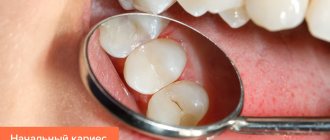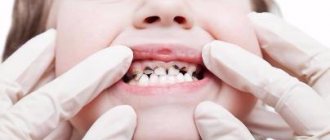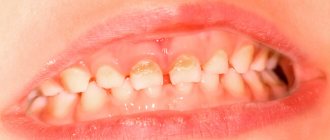If a carious stain goes unnoticed, the tooth continues to decay and superficial caries develops. Like the previous stage, the lesion is localized within the enamel.
Various reasons contribute to the development of the disease:
- predominance of sugars and acids in the diet;
- deficiency of vitamins and microelements;
- hereditary factor;
- disturbances in the composition of saliva;
- poor oral hygiene.
Contact numbers of our clinics:
Belorusskaya (+7
or Leave a request and we will call you back
Leave feedback
Symptoms of superficial caries
Symptoms of superficial caries depend on the resistance of hard tissues. With a high level of hygiene and mineralization of the enamel, the disease progresses slowly, and its signs may be absent. Upon examination, the dentist finds only minor irregularities in the upper layer of the tooth.
A poor level of hygiene or insufficient mineralization can turn superficial caries into multiple ones, and then it will quickly move into the middle stage of development, when dentin is already affected. In such cases, a short-term but noticeable reaction to cold, hot, sour, and sweet appears. And when a defect forms in the cervical area, discomfort is felt due to mechanical irritation, for example, from a toothbrush.
Pathogenesis
The development of the disease is influenced by many factors. In particular, the frequency and quantity of consumption of sweet and starchy foods, as well as poor oral care, are important. The more often a person eats sweets and the longer they act on tooth enamel, the more actively plaque forms and the faster demineralization of the enamel occurs.
Bacteria actively multiply in dental plaque and produce organic acids during their life. They cause changes in the acid-base balance towards an acidic pH, which also helps to weaken and corrode the enamel and create favorable conditions for the removal of the minerals most important for the strength of teeth - calcium, fluorine and phosphorus.
In the oral cavity, the processes of mineralization and demineralization, as well as neutralization of organic acids, occur simultaneously. At the moment when the rate of removal of minerals from hard tissues begins to prevail over the rate of their entry into the dental structures, and also when the process of acid formation dominates over its neutralization, a defect is formed. Initially, it does not go beyond the boundaries of the enamel-dentin junction (the area where the enamel borders the dentin).
If the process is left without treatment, then caries destroys the deep layers of dentin, gradually reaches the location of the neurovascular bundle (pulp chamber) and pulpitis begins, and later periodontitis. Without medical intervention at this stage, tooth loss may occur.
Treatment of superficial caries without filling
The method of treating superficial caries depends on the severity of the process. If the damage is minor and the thickness of the top layer in this area is large, you can do without filling. The roughness is simply ground off, after which the tooth is thoroughly polished. This prevents the possibility of easy plaque formation in the same place.
The next stage in the treatment of superficial caries is restoration of the structure of tooth enamel through deep fluoridation of teeth. This procedure in dentistry is carried out both to prevent caries and to stabilize the process of tooth decay when it has already begun.
Diagnostic methods
Clinical diagnosis, carried out as part of an examination of the oral cavity, involves the use of various techniques to determine the degree of development of pathology. Over time, superficial caries can develop into a more severe form that affects dentin and the pulp chamber, so it is important to promptly select the optimal treatment method.
Current examination methods used in clinics include:
- Visual inspection and percussion - assessment of the condition of the dentition by tapping the elements, allowing to identify the patient’s reaction;
- Probing is a technique that allows you to determine the presence of superficial caries by detecting a rough texture on the surface of the enamel;
- Staining – the use of special dyes that form markers in affected areas characterized by insufficient mineralization;
- Antiseptic drying - applying a special composition to the dentition, which, under the influence of a directed light flux, indicates defective areas;
- Differential diagnosis is a procedure that involves comparing the basic symptoms observed in the patient.
The final cost of dental services consists of many factors - as a rule, the price for caries treatment in St. Petersburg clinics is agreed upon based on the results of a preliminary diagnosis, which determines the structure of the treatment plan.
Caries of permanent teeth in children
Newly erupted teeth have lower mineralization, which is finally completed only by 4-5 years after eruption. Young permanent teeth are especially vulnerable in the first year of development. The enamel on them is easily permeable to caries bacteria, so a junior schoolchild should be helped to brush his teeth and be sure to consult with a dentist about the need to seal the fissures and make a protective coating for the enamel.
Meet our tooth fairies and check prices.
Clinical researches
Asept products are clinically proven effective. For example, clinical studies have proven that regular use of professional toothpaste ASEPTA REMINERALIZATION improved the condition of the enamel by 64% and reduced tooth sensitivity by 66% after just 4 weeks. According to tests, using ASEPTA propolis gum gel for a week can reduce gum inflammation by 31%.
In addition, clinical studies have proven that regular use of preventive toothpaste ASEPTA ACTIVE for a month can reduce bleeding gums by 60%, improve the overall condition of the oral cavity by 44% and reduce inflammation by 33%.
Sources:
- Report on the determination/confirmation of the preventive properties of personal oral hygiene products “ASEPTA PLUS” Remineralization doctor-researcher A.A. Leontyev, head Department of Preventive Dentistry, Doctor of Medical Sciences, Professor S.B. Ulitovsky First St. Petersburg State Medical University named after. acad. I.P. Pavlova, Department of Preventive Dentistry
- The effectiveness of the use of Asept “adhesive balm” and Asept “gel with propolis” in the treatment of chronic generalized periodontitis and gingivitis in the acute stage (Municipal Dental Clinic No. 4, Bryansk, Kaminskaya T. M. Head of the therapeutic department Kaminskaya Tatyana Mikhailovna MUZ City Dental Clinic No. 4, Bryansk
- Clinical and laboratory assessment of the influence of domestic therapeutic and prophylactic toothpaste based on plant extracts on the condition of the oral cavity in patients with simple marginal gingivitis. Doctor of Medical Sciences, Professor Elovikova T.M.1, Candidate of Chemical Sciences, Associate Professor Ermishina E.Yu. 2, Doctor of Technical Sciences Associate Professor Belokonova N.A. 2 Department of Therapeutic Dentistry USMU1, Department of General Chemistry USMU2
Complications of caries in children: pulpitis and periodontitis
Pulpitis is an inflammation of the neurovascular bundle of a tooth (where its nerve endings and blood vessels are located). Pulpitis can develop from caries very quickly - within 3-4 months. Up to three years of age, pulpitis of primary teeth in children usually develops on the front teeth, after three years - on the chewing teeth. In acute pulpitis, the pain in the tooth is very severe, the temperature may rise, and the child refuses to eat.
Chronic pulpitis in children can occur asymptomatically or be similar in symptoms to deep caries. Such pulpitis develops under fillings or in teeth with advanced caries. If a child of any age develops pulpitis, he must be treated immediately, since pulpitis, in turn, is fraught with serious complications.
Periodontitis is an inflammation of the tissues located near the root of the tooth. Acute periodontitis in children develops quickly and leads to severe pain in the affected area, especially when pressing or touching hot food. The general condition deteriorates sharply, the body temperature can rise to 39 degrees, the child cannot eat. Chronic periodontitis in children can develop slowly and is characterized by mild pain when pressing on the tooth or chewing on the affected side. The mucous membrane next to the tooth swells and becomes bright red.
Special offer
Participate in the promotion
Promotion “1+1”: child and parent
You have entrusted NovaDent with the treatment of your child’s teeth, as a token of gratitude we are giving you a free consultation with any specialist (surgeon, implantologist, therapist, orthodontist, hygienist), as well as an orthopantomogram (panoramic photograph of the teeth) sent by email.
Take time for your health and take advantage of this great offer! Participate in the promotion
Expert of the article you are reading: Lapshina Maria Aleksandrovna Dentist, pediatrician
20 years
Clinical experience
Krasnogorsk
Moscow region, Krasnogorsk, Podmoskovny Boulevard, 5
+7
Free consultation with this specialist
Causes
Experts have come to the conclusion that the cause of the development of superficial caries is pathogenic microorganisms - streptococci. Note that these bacteria are present on the mucous membrane of every person; in minimal quantities they do not cause harm. Once disposition factors occur in the body, there is a significant increase in “bad” bacteria. These factors include:
- Low body defenses.
- Avitaminosis.
- Lack of useful microelements.
- Poor nutrition.
- Poor quality water.
Secondary reasons include the following:
- Insufficient oral hygiene.
- Pieces of food stuck between teeth that were not removed in a timely manner.
- Accompanying illnesses.
Genetic predisposition should also be noted. If your close relatives have similar problems, most likely you will also experience superficial caries. The sooner treatment is started, the higher the chances of avoiding serious complications.
Seals
Dental treatment and installation of a filling in Korolev is a labor-intensive process that requires high professionalism from the doctor so that it does not fall out untimely or break. In addition, the material from which the filling is made also affects the quality of treatment and the health of the tooth in general.
Fillings are needed for the treatment of caries, dental canals, wedge-shaped defects, as well as for the aesthetic restoration of damaged teeth.
A filling is a plastic and viscous medical material that gradually hardens in the tooth cavity on its own or under the influence of external factors. In our dentistry in Korolev, dental therapists use reflective fillings made from insoluble, safe and resistant materials that meet established hygienic standards.
Thanks to light fillings, restoration and treatment of anterior teeth can be carried out without difficulty. With this material you can easily and quickly sculpt a beautiful and correct shape, fixing the result with ultraviolet radiation.
Diagnosis of caries in children
How to recognize caries in a child? A parent cannot always do this, since caries in children becomes noticeable only when there is already a hole in the tooth. Often a child is brought to the dentist “just to check his teeth,” and the doctor finds several caries after examining him with instruments.
The usual methods for diagnosing caries are inspection and probing. As a rule, this is enough to determine the presence of caries. The depth of the lesion can be assessed based on the child’s complaints and by x-ray examination.
Deep caries in a child is visible to the naked eye. At the same time, deep carious lesions on a tooth will almost always require x-rays so that the doctor can understand how far the carious process has gone, whether it is possible to save the tooth or whether removal is necessary.
Preventive actions
Prevention of initial caries is aimed at proper oral hygiene. Try to brush your teeth after every meal. Use an antibacterial mouthwash and remember to brush the insides of your cheeks and tongue. Buy dental floss to easily remove food debris between your teeth. If finances allow, purchase an irrigator. This device thoroughly cleans teeth and removes pathogenic microorganisms from the enamel surface.
Let's consider a few more tips:
- Eat a balanced diet so that your body does not experience a deficiency of vitamins and microelements. Strengthen your immune system in every possible way. And, the most important rule, visit the dentist more often and promptly begin treatment for various oral ailments.
- It is important to maintain normal oral microflora. For this reason, you need to start treating colds in a timely manner and check your stomach condition once a year.
- An excellent preventative measure is to coat the enamel with fluoride varnish. This coating prevents bacteria from multiplying and prevents the development of superficial caries. For the highest efficiency, the procedure is carried out only 2 times a year.
- Dose out sweets, especially for children. Such products provoke the growth of bacteria. You should also limit liquids, which wash calcium from the body and make the enamel more vulnerable to the development of superficial caries.










